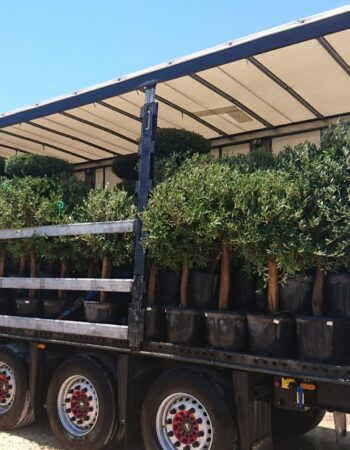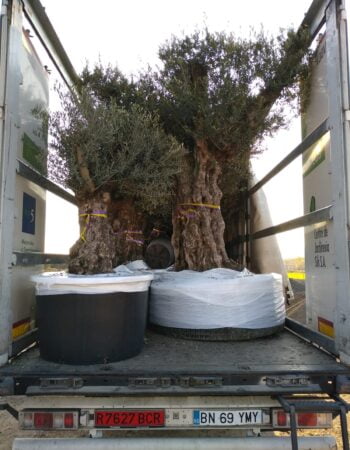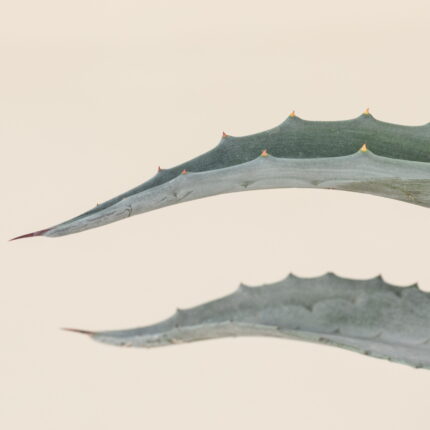Aloe arborescens
Aloe arborescens, commonly known as Candelabra Aloe or Torch Aloe, is a striking, large, and fast-growing succulent native to South Africa. It is known for its branching, tree-like structure and beautiful, bright orange-red flowers that bloom in winter. The leaves are thick, fleshy, and arranged in a rosette pattern, with a slightly curved shape and serrated edges. Aloe arborescens is highly valued for its ornamental appeal and medicinal properties, making it a popular choice for gardens and landscapes in warm climates.
- Botanical Name: Aloe arborescens
- Common Names: Candelabra Aloe, Torch Aloe, Krantz Aloe
- Mature Height: 6-10 feet (1.8-3 meters)
- Mature Spread: 4-6 feet (1.2-1.8 meters)
- Growth Rate: Fast
- Light Requirements: Full sun to partial shade
- Soil Requirements: Well-draining soil; prefers sandy or rocky soils
- Water Needs: Low; drought-tolerant
- Foliage: Thick, fleshy, green to gray-green leaves with serrated edges, arranged in rosettes
- Flowers: Bright orange-red, tubular flowers on tall spikes, blooming in late fall to winter
Uses:
- Ornamental: Aloe arborescens is a stunning addition to gardens and landscapes, providing year-round interest with its architectural form and vibrant winter flowers.
- Medicinal: Like Aloe vera, Aloe arborescens has medicinal properties; the gel from its leaves can be used to soothe burns, cuts, and skin irritations.
- Hedges and Borders: It can be planted as a natural barrier or hedge, thanks to its dense growth and spiky leaves.
- Erosion Control: Its extensive root system helps in stabilizing soil and preventing erosion on slopes and hillsides.
Benefits:
- Drought Tolerance: This plant is highly drought-tolerant, making it ideal for xeriscaping and low-water gardens.
- Year-Round Interest: Provides visual interest throughout the year with its evergreen foliage and bright winter blooms.
- Wildlife Attraction: The bright flowers attract pollinators such as bees, butterflies, and birds, adding biodiversity to your garden.
- Low Maintenance: Requires minimal care, making it suitable for busy gardeners or those new to gardening.
Aloe arborescens is a versatile and robust plant that adds beauty and practicality to any garden or landscape. Its combination of ornamental appeal, drought tolerance, and medicinal uses makes it a valuable addition to any plant collection.
Debes acceder para publicar una valoración.


CAREFUL TREE TRANSPORTATION
At Treezom, we take great care in transporting your trees to ensure they arrive in perfect condition. Our expert team uses various methods, depending on the size and volume of the order, to provide safe and efficient delivery. Whether you're ordering a single tree or a bulk order, we guarantee high standards of handling and care throughout the process.
MULTIPLE SHIPPING METHODS
- Truck Delivery: Ideal for local or regional deliveries, ensuring a smooth and timely shipment of your trees directly to your location.
- Sea Containers (20’ or 40’): Perfect for larger orders or international shipping. Our sea containers are equipped to handle bulk shipments with optimal protection.
- Other Customized Solutions: Depending on the size and nature of your order, we can offer tailored shipping methods to meet your specific needs.
No matter the shipping method, we use specialized packaging and handling procedures to protect the trees during transit, ensuring they arrive healthy and ready for planting.
Below, you’ll find key tips tailored to this species’ requirements. Whether you’re new to plant care or have plenty of experience, these guidelines are here to support you in keeping your green companion healthy and vibrant.
- Planting:
- Select a location with full sun to partial shade; ideal for bright, sunny spots.
- Plant in well-draining soil, such as cactus or succulent mix.
- If planting in a container, ensure it has adequate drainage to prevent water retention and root rot.
- Space plants sufficiently to accommodate their mature size, allowing room for branching and spreading.
- Watering:
- Water deeply but infrequently, allowing the soil to dry out completely between waterings.
- During the growing season (spring and summer), water approximately once every two weeks.
- In fall and winter, reduce watering to once a month or less, depending on rainfall and temperature.
- Avoid overwatering, as this can lead to root rot and other fungal diseases.
- Pruning:
- Remove any dead or damaged leaves by cutting them close to the stem to maintain the plant's appearance.
- After flowering, cut back spent flower spikes to encourage new growth.
- Prune to control size and shape, especially if the plant becomes too large for its space.
- Fertilizing:
- Fertilize sparingly with a balanced, water-soluble fertilizer diluted to half strength during the growing season.
- Aloe arborescens typically requires minimal fertilization; over-fertilizing can lead to excessive growth and weakened plants.
- Pest and Disease Control:
- This aloe is relatively resistant to pests but can occasionally be affected by aphids, scale insects, or mealybugs; treat with insecticidal soap or neem oil if necessary.
- Ensure good air circulation to prevent fungal infections and other diseases.
- Regularly inspect the plant for signs of pests or disease and address any issues promptly.
*This information is provided for informational purposes only. For more detailed care, please consult a professional Gardener or Arborist.


 SINGLE TREE
SINGLE TREE OUTDOOR POTS
OUTDOOR POTS


























 Single Tree
Single Tree
Valoraciones
No hay valoraciones aún.